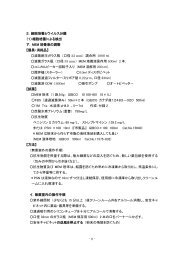Program and Abstracts(PDF)
Program and Abstracts(PDF)
Program and Abstracts(PDF)
Create successful ePaper yourself
Turn your PDF publications into a flip-book with our unique Google optimized e-Paper software.
Presentation 8<br />
SPAWNING AND LARVAL REARING OF YELLOWTAIL AMBERJACK (Seriola<br />
lal<strong>and</strong>) IN SOUTHERN CALIFORNIA<br />
Kevin Stuart* <strong>and</strong> Mark Drawbridge<br />
Hubbs-SeaWorld Research Institute 2595 Ingraham St. San Diego, CA 92109, USA<br />
*Email: kstuart at hswri.org<br />
Hubbs-SeaWorld Research Institute (HSWRI) has been rearing yellowtail amberjack (Seriola<br />
lal<strong>and</strong>i), known locally as California yellowtail, at its laboratory in San Diego since 2003. The<br />
broodstock have been spawning naturally in a 140 m 3 maturation pool since 2002. The sex ratio<br />
has been close to 1:1 <strong>and</strong> spawning typically occurs between 16.5 <strong>and</strong> 22.0°C (April thru August).<br />
The number of adults has ranged from 21 to 35 <strong>and</strong> associated individual weights from 8.2 to<br />
20.8 kg. Our primary egg quality measures have shown inconsistent spawn quality within a<br />
spawning season, with hatch rates ranging from 10 – 90% <strong>and</strong> survival to first feeding ranging<br />
from 5 – 80%. Typically the highest quality spawns are seen early in the season. The numbers<br />
of spawning events <strong>and</strong> eggs per spawn have increased in recent years due to increasing female<br />
biomass <strong>and</strong> improvements to the broodstock feeding regime.<br />
Recent research results on yellowtail have shown no significant differences in growth or<br />
survival at 10 dph among egg stocking densities of 50, 100, <strong>and</strong> 200 eggs per L. Greenwater was<br />
demonstrated to be beneficial to larvae up to 16 dph as was 24hr light <strong>and</strong> high light intensity of<br />
5,000 to 13,000 lux. There were no significant differences in growth or survival when yellowtail<br />
larvae were fed at rotifer densities of 15, 30, <strong>and</strong> 45 rotifers per ml. Larvae were able to consume<br />
1 st instar Artemia (Artemia franciscana) as early as 6 dph. Finally, we determined that<br />
greenwater rearing conditions created using either SanoLife ALG (INVE), algae paste, or live<br />
algae all produced similar results.<br />
Our current culture protocols for production include 1) stocking eggs at a density of 100 per<br />
L; 2) maintaining water temperature at 21.0 – 22.0 °C; 3) providing rotifers (Brachionus<br />
rotundiformis) from 2 to 9 dph at 20 per ml; 4) moving larvae from tall, narrow 1600L egg<br />
incubators to shallow, wide 8,000L tanks at 10 dph; 5) providing 1 st instar Artemia (Artemia<br />
franciscana) from 6 to 10 dph <strong>and</strong> 2nd instar Artemia from 10 to 35 dph; 6) providing 24hr light<br />
at 5,000 to 13,000 lux above each tank; <strong>and</strong> 7) greening the water using SanoLife ALG from 2 to<br />
17 dph.<br />
These procedures yielded survival rates from egg to juvenile of up to 5% with a relatively<br />
high degree of variability. High larval mortality, from unidentified causes at around 17 - 20 dph<br />
<strong>and</strong> deformity rates as high as 40% are focal areas for improvement through future research.<br />
18



